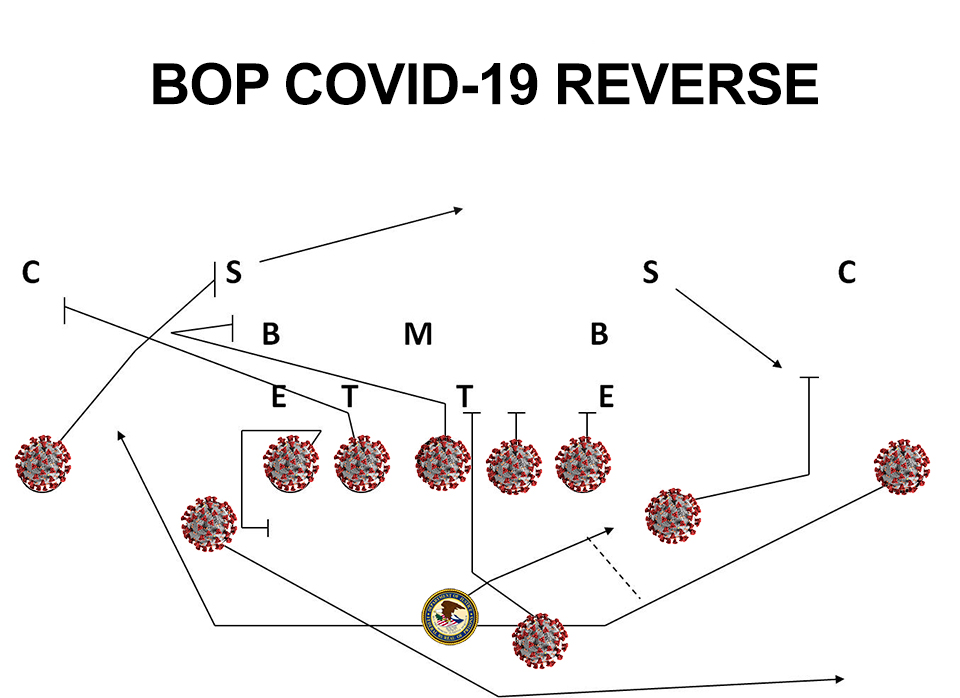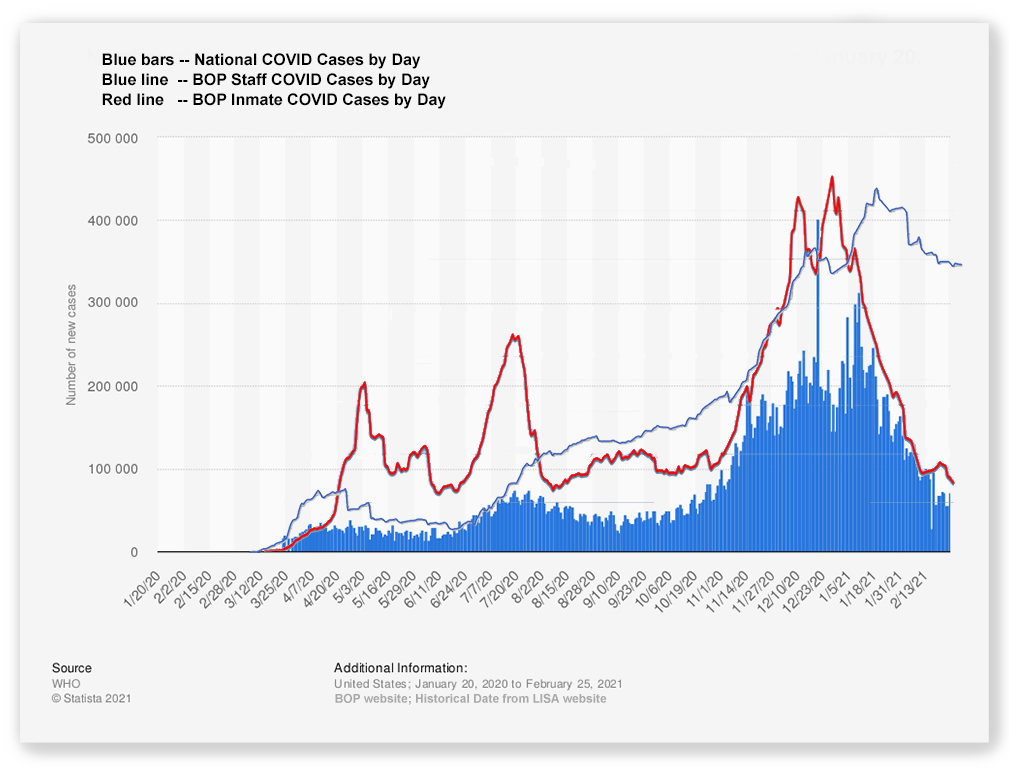We post news and comment on federal criminal justice issues, focused primarily on trial and post-conviction matters, legislative initiatives, and sentencing issues.

BOP RUNS A REVERSE ON COVID TESTING
The BOP COVID numbers kept plummeting last week, ending the day yesterday with 783 sick inmates, down 46% in a week. But, strangely enough, staff COVID numbers remain stubbornly high at 1,569, nearly at the level of a week before. COVID is still in 126 BOP facilities.
For over 10 months, inmate COVID cases always exceeded staff cases, once by a factor of five. But on Feb 11, the number of staff cases passed the number of inmate cases for the first time. Last Friday, it was 100% higher.
This may be why: Last April, the BOP warned its increased inmate testing program would “increase the number of COVID-19 positive tests reflected on the BOP’s… public website.” Now, someone at Central Office has figured out that the obverse is equally true: less testing decreases the number of inmate COVID cases.
From Aug 1 through Feb 15, the BOP averaged 331 tests a day. But since Feb 15, the testing rate has fallen dramatically. Last week, the daily average was 44 tests a day. Yesterday, the BOP reported only 32 inmate tests in the entire system.
It’s not like the BOP has run out of people to test. Its own numbers show that about 45,000 inmates have never been tested. The current positivity rate of 44% – meaning that 44 out of 100 inmates tested had the virus – suggests about 20,000 undetected cases are still in the system.
 The BOP does not control the staff COVID numbers: staffers get their own tests. So the inmate number, which the BOP controls, keeps falling. The staff number it does not control continues to reflect reality.
The BOP does not control the staff COVID numbers: staffers get their own tests. So the inmate number, which the BOP controls, keeps falling. The staff number it does not control continues to reflect reality.
The BOP’s numbers last Friday showed that 41% of the staff have gotten the COVID vaccine, while only 8.4% of inmates have been inoculated. Only 72% of all BOP facilities report receiving the vaccine, with FCI Marianna having the highest percentage of inmates vaccinated, 53.5%, while three reporting facilities – Seatac, Miami, and Devens – report no inmates have taken the shot. A total of 2,233 inmates (1.5% of all inmates) were vaccinated last week.
The BOP told a Connecticut federal court last week (in a case involving FCI Danbury) that inmates who decline vaccinations without a documented medical reason will not be given further consideration for CARES Act home confinement. The BOP said it would consider home confinement for inmates who accept vaccinations, up until the time they are fully inoculated (usually two weeks after receiving the second dose).
 An article in The Regulatory Review argued the Dept of Justice’s January legal opinion that people in home confinement had to be recalled to federal prisons after the pandemic ended is flawed: “What the CARES Act limits to the covered emergency period is the Bureau Director’s authority to lengthen the permissible amount of time that people can spend in home confinement. Once a person’s home confinement period is properly lengthened by the Bureau — during the emergency, when the Bureau has the authority to do so — nothing in the law requires that someone’s period of home confinement must be shortened once the pandemic is over. The statute only limits when the Bureau of Prisons has authority to move people into home confinement for longer durations of their sentence.”
An article in The Regulatory Review argued the Dept of Justice’s January legal opinion that people in home confinement had to be recalled to federal prisons after the pandemic ended is flawed: “What the CARES Act limits to the covered emergency period is the Bureau Director’s authority to lengthen the permissible amount of time that people can spend in home confinement. Once a person’s home confinement period is properly lengthened by the Bureau — during the emergency, when the Bureau has the authority to do so — nothing in the law requires that someone’s period of home confinement must be shortened once the pandemic is over. The statute only limits when the Bureau of Prisons has authority to move people into home confinement for longer durations of their sentence.”
Finally, the Bureau of Prisons Reform Caucus, which started with a couple of congressmen last fall, has added to its membership and purpose. Now with at least eleven congressmen and women as members, the Caucus issued a series of statements last week on its purpose and plans. Caucus chair Fred Keller (R-Pennsylvania) said, “This pandemic has brought to light many failures in the BOP’s operations, including detrimental inmate transfer policies, staffing shortages, and agency retention issues. The various backgrounds and experiences of the members of this caucus will enable us to better tackle these issues on behalf of the American people.”
Press Release, BOP Expands COVID-19 Testing (Apr 24, 2020)
Associated Press, Inmates refuse inoculations in Connecticut federal prison (March 3, 2021)
The Regulatory Review, The Justice Department Should Preserve Home Confinement (March 1, 2021)
NorthCentralPA.com, Bureau of Prisons Reform Caucus releases series of statements on future plans, accountability (March 5, 2021)
– Thomas L. Root






 There is little doubt that this issue, and probably the whole “attempt” furball, is headed for the Supreme Court.
There is little doubt that this issue, and probably the whole “attempt” furball, is headed for the Supreme Court.























